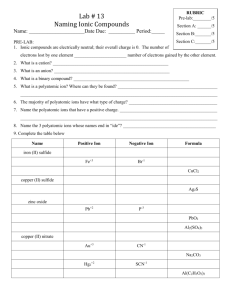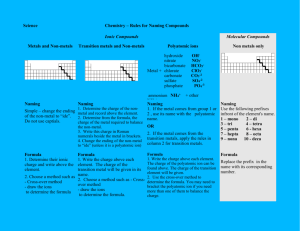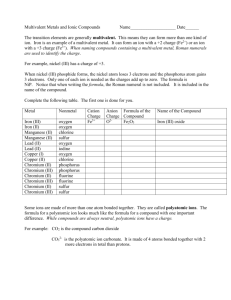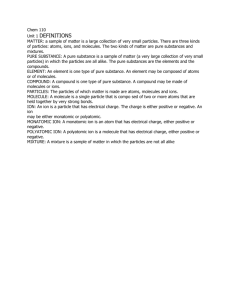A) Naming Monatomic ions (15 min)
advertisement
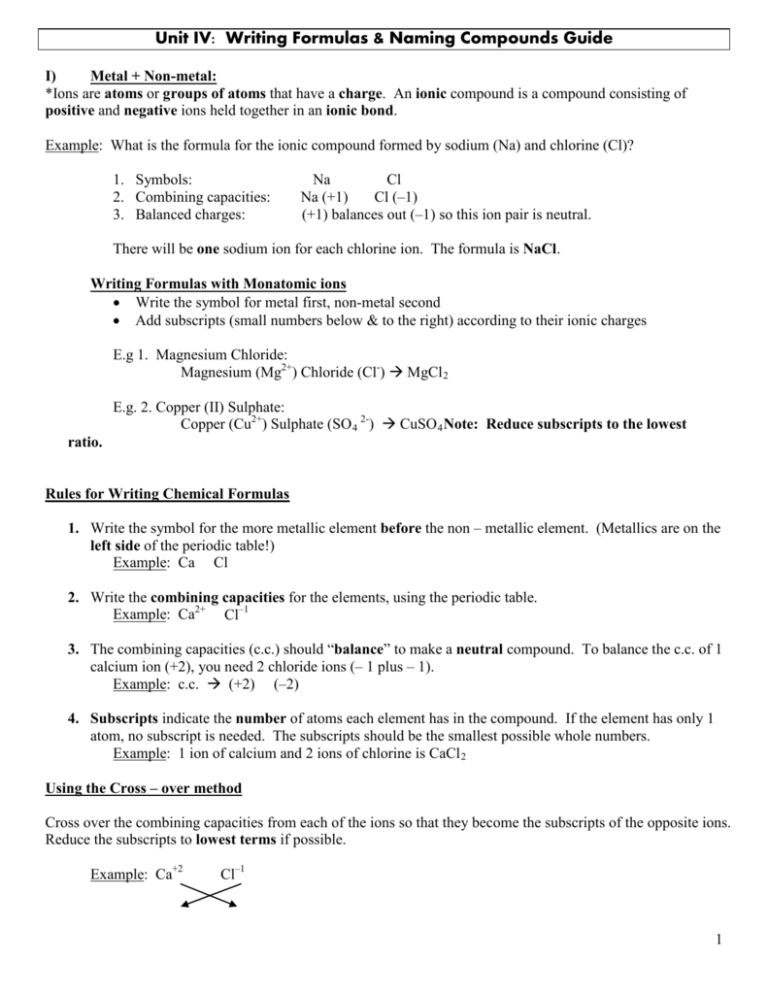
Unit IV: Writing Formulas & Naming Compounds Guide I) Metal + Non-metal: *Ions are atoms or groups of atoms that have a charge. An ionic compound is a compound consisting of positive and negative ions held together in an ionic bond. Example: What is the formula for the ionic compound formed by sodium (Na) and chlorine (Cl)? 1. Symbols: 2. Combining capacities: 3. Balanced charges: Na Cl Na (+1) Cl (–1) (+1) balances out (–1) so this ion pair is neutral. There will be one sodium ion for each chlorine ion. The formula is NaCl. Writing Formulas with Monatomic ions • Write the symbol for metal first, non-metal second • Add subscripts (small numbers below & to the right) according to their ionic charges E.g 1. Magnesium Chloride: Magnesium (Mg2+) Chloride (Cl-) MgCl 2 E.g. 2. Copper (II) Sulphate: Copper (Cu2+) Sulphate (SO 4 2-) CuSO 4 Note: Reduce subscripts to the lowest ratio. Rules for Writing Chemical Formulas 1. Write the symbol for the more metallic element before the non – metallic element. (Metallics are on the left side of the periodic table!) Example: Ca Cl 2. Write the combining capacities for the elements, using the periodic table. Example: Ca2+ Cl–1 3. The combining capacities (c.c.) should “balance” to make a neutral compound. To balance the c.c. of 1 calcium ion (+2), you need 2 chloride ions (– 1 plus – 1). Example: c.c. (+2) (–2) 4. Subscripts indicate the number of atoms each element has in the compound. If the element has only 1 atom, no subscript is needed. The subscripts should be the smallest possible whole numbers. Example: 1 ion of calcium and 2 ions of chlorine is CaCl 2 Using the Cross – over method Cross over the combining capacities from each of the ions so that they become the subscripts of the opposite ions. Reduce the subscripts to lowest terms if possible. Example: Ca+2 Cl–1 1 Ca 1 Cl 2 Ca 1 Cl 2 CaCl 2 Naming Compounds Metal + Monatomic Ions • Write the name of the metal first, then the non-metal • Drop ending of non-metal (usually “ine” and add “ide”) *See table below for examples. E.g. 1. MgO magnesium oxide CaF 2 calcium fluoride Naming Monatomic Non-metal Ions: Element name Symbol Ion name Ion symbol Fluorine F Fluoride FChlorine Cl Chloride ClBromine Br Bromide BrIodine I Iodide I*** Oxygen O Oxide O22*** Sulphur S Sulphide S Selenium Se Selenide Se2- *** *** Nitrogen N Nitride N33*** Phosphorus P Phosphide P *** Carbon C Carbide C4Note: *** Students’ common mistake!!! Q: If a metal has more than one combining capacity, how do you know which one is it? • Use the Roman numeral to indicate the charge/combining capacity. • Place the Roman numeral charge value in brackets between the metal name and the word ion. Fe3+ = iron (III) ion, Fe2+ = iron (II) ion, Cu1+ = copper (I) ion, Cu2+ = copper (II) ion E.g. Cu(SO 4 ) 2 copper (I) sulfate Cu(SO 4 ) copper (II) sulfate 2 II) Metal + Non-metal (Polyatomic ions): • Polyatomic ions act as a group (as if they were one element) that carry an overall charge as a group • They are usually negative, non-metals, ending in “ate” or sometimes “ide” or “ite” • Except for ammonium ion which is a positive, polyatomic metallic ion. Writing Formulas • Same as before, o Write the symbol for metal first, non-metal second o Add subscripts (small numbers below & to the right) according to their ionic charges • But you need to use a bracket to for the group of polyatomic atoms if you have >1 group Example potassium sulfate K 2 SO 4 nickel (III) dichromate Ni 2 (Cr 2 O 7 ) 3 Treat a polyatomic ion as a single ion. Example: Hydroxide = (OH)–1 Carbonate = (CO 3 )–2 Example: We used a chemical in the lab called sodium carbonate (Na 2 CO 3 ). The compound contains 2 sodium ions and 1 polyatomic carbonate ion. CO 3 –2 Na+1 Na 2 (CO 3 ) 1 Answer is Na 2 CO 3 To name formulas that contain polyatomic ions, do not change the endings of the polyatomic ion. Example: FeCO 3 NH 4 Cl Iron (II) carbonate Ammonium chloride Naming Compounds a) Metal + Polyatomic Ions • Write the name of the metal first, then the non-metal • Don’t need to change the ending “ate” E.g. KMnO 4 potassium permanganate Mn 2 (CO 2 ) 3 manganese (III) carbonate *Exception: Ammonium (positive metallic) Don’t change its ending & write it 1st as a metal! E.g. NH 4 OH ammonium hydroxide (NH 4 ) 2 SO 4 ammonium sulphate (or sulfate) Some Common Polyatomic Ions (See Hebden, p. 341) Carbonate = CO 2 Nitrate = NO 3 Phosphate = PO 4 3Hydroxide = OHDichromate = Cr 2 O 7 2- Ammonium = NH 4 + Chromate = CrO 4 2Acetate = CH 3 COOSulfate (Sulphate) = SO 4 2Permanganate = MnO 4 2- 3 III) Non-metal + Non-Metal • Non-metals form COVALENT COMPOUNDS. They don’t follow the regular rules, so prefixes are required to show the number of atoms present in each compound. Learn these prefixes!!! Prefix # of atoms/ # of water molecules mono 1 di 2 tri 3 tetra 4 penta 5 Hexa 6 hepta 7 octa 8 nona 9 deca 10 Writing Formulas • Write the symbol for the more metallic, positive element first • Add subscripts (small numbers below & to the right) and the prefixes tell you how many of each atom there is in the compound. E.g 1. Trinitrogen tetroxide N 3 O 4 Carbon momoxide CO Carbon dioxide CO 2 Naming Compounds • Place the prefixes before the name of each element according to the number of atoms present in the formula • Leave out MONO if it comes before the first element E.g. P 2 O 5 = diphosphorus pentoxide CCl 4 = carbon tetrachloride not monocarbon tetrachloride Contraction: The last vowel of these 3 prefixes (MONO, TETRA & PENTA) are dropped when combined with a compound beginning with a vowel. • Mono + oxide --> monoxide but Di + iodine --> diiodine • Tetra + oxide --> tetroxide Tri + iodine --> triiodine • Penta + oxide --> pentoxide Hexa + oxide --> hexaoxide etc. 4 IV) Naming Hydrates • Hydrates are solid compounds that contain water molecules. • E.g. Crystallized ionic solids --- When solids crystallize from aqueous solutions, they frequently include have water molecules surrounding them. • E.g. Al 2 O 3 ·3H 2 O, means 3 water molecules surround every one Al 2 O 3 group. Naming Hydrates & Writing Formulas • Just like before. Next, include the “hydrate” part. • The prefixes tell you the number of water molecules E.g. CuSO 4 ·5H 2 O = copper (II) sulphate pentahydrate Zn(CH 3 COO) 2 = zinc acetate dihydrate Na 2 CO 3 .H 2 O = sodium carbonate monhydrate V) Common acids • An acid is a compound starting with an H for hydrogen and has a pH level less than 7. • Most acids are oxoacids. That is they contain oxygen in addition to hydrogen and another element. • When dissolved in water, an oxoacid yields one ore more H+ ions and a polyatomic oxianion. Naming Oxoacids: • Name the oxoanion + acid • Change “ite” “ous” or “ate” “ic” E.g. Oxoacid Oxoanion HNO 2 Nitrous acid NO 2 - Nitrite ion HNO 3 Nitric acid NO 3 - Nitrate ion Some other acids that are not oxacids are: • HF = hydrofluoric acid • HCl = hydrochloric acid Q: How would you name HBr? Hydrobromic acid Q: How would you name HI? Hydroiodic acid Examples: Oxoacid HNO 2 Nitrous acid HNO 3 Nitric acid H 3 PO 4 Phosphoric acid H 2 SO 3 Sulphrous acid H 2 SO 4 Sulphuric acid HClO Hypochlorous acid HClO 2 Chlorous acid HClO 3 Chloric acid HClO 4 Perchloric acid Oxoanion NO 2 - Nitrite ion NO 3 - Nitrate ion PO 4 3- Phosphate ion SO 3 2- Sulphite ion SO 4 2- Sulphate ion ClO- Hypochlorite ion ClO 2 - Chlorite ion ClO 3 - Chlorate ion ClO 4 - Perchlorate ion 5
